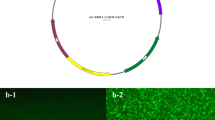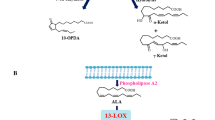Abstract
Lipoxygenase (LOX) activity was measured in germinating pigeonpea Cajanus cajan seedlings, resistant (ICP-8863) and susceptible (ICP-2376) to wilt fungus, before and after infection with Fusarium udum. LOX activity was significantly higher in the resistant than in the susceptible cultivars of pigeonpea and was enhanced further in response to infection with Fusarium udum. This increase in LOX activity in the resistant cultivars of pigeonpea appears to be due to the induction of lipoxygenase isozymes in response to infection. Analysis of the endogenous LOX metabolites in pigeonpea seedlings revealed the predominant formation of 13-hydroperoxyoctadecadienoic acid (13-HPODE) in healthy seedlings and 13-hydroperoxyoctadecatrienoic acid (13-HPOTrE) in infected seedlings. Further studies on the effects of LOX metabolites on the growth and multiplication of Fusarium udum showed that HPOTrEs, LOX metabolites of α-linolenic acid, are more anti-fungal compared to HPODEs, LOX metabolites of linoleic acid.
Similar content being viewed by others
References
Creelman RA and Mullet JE (1995) Jasmonic acid distribution and action in plants: regulation during development and response to biotic and abiotic stress. Proc Natl Acad Sci USA 92: 4114-4119
Croft KPC, Voisey CR and Slusarenko AJ (1990) Mechanism of hypersensitive cell collapse: correlation of increase lipoxygenase activity with membrane damage in leaves of Phaseolus vulgaris cv Red Mexican inoculated with avirulent race/cells of Pseudomonas syringae pv. Phaseolicola. Physiol Mol Plant Pathol 36: 49-62
Farmer EE and Ryan CA (1990) Interplant communication: airborne methyl jasmonate induces synthesis of proteinase inhibitors in plant leaves. Proc Natl Acad Sci USA 87: 7713-7716
Farmer EE and Ryan CA (1992) Octadecanoid precursors of jasmonic acid activate the synthesis of wound inducible proteinase inhibitors. Plant Cell 4: 129-134
Farmer EE, Johnson RR and Ryan CA (1992) Regulation of expression of proteinase inhibitor genes by methyl jasmonate and jasmonic acid. Plant Physiol 98: 995-1002
Fournier J, Pouenat KL, Rickauer M, Rabinovitch-Chable H, Rigaud M and Esquerre-Tugaye MT (1993) Purification and characterization of elicitor-induced lipoxygenase in tobacco cells. Plant J 3: 63-70
Galliard T (1978) Lipolytik and lipoxygenase enzymes in plants and their action in wounded tissues. In: Kahl G (ed) Biochemistry of wounded plant tissues (pp 155-201) Walter de Gruyter and Co., Berlin
Gardner HW (1991) Recent investigations into the lipoxygenase pathway of plants. Biochim Biophys Acta 1084: 221-239
Hamberg M and Gardner HW (1992) Oxylipin pathway to jasmonates: Biochemistry and biological significance. Biochim Biophys Acta 1165(1): 1-18
Hildebrand DF, Hamilton-Kemp TR, Legg CS and Bookjans G (1988) Plant lipoxygenases: occurrence, properties and possible functions. Curr Top Plant Biochem Physiol 7: 201-219
Heydeck D and Schewe T (1985) Improved procedure for the detection of activity of lipoxygenases on electrophoregrams. Biomed Biochem Acta 44: 1261-1263
Kato T, Maeda Y, Kirukawa T, Namai T and Yoshioka N (1992) Lipoxygenase activity increment in infected tomato leaves and oxidation product of α-linolenic acid and its in vitro enzyme reaction. Biosci Biotech Biochem 56: 373-375
Koch E, Meier BM, Eiben HG and Slusarenko A (1992) A lipoxygenase from leaves of tomato (Lycopersicon esculentum Mill.) is induced in response to plant-pathogenic pseudomonas. Plant Physiol 99: 571-576
Lowry OH, Rosebrough NJ, Farr AL and Randall RJ (1951) Protein measurement with the folin phenol reagent. J Biol Chem 193: 265-275
Lupu R, Grossman S and Cohen Y (1980) The involvement of lipoxygenase and antioxidants in pathogenesis of powdery mildew on tobacco plants. Physiol Plant Pathol 16: 241-248
Melan MA, Dong X, Endara ME, Davis KR, Ausubel GM and Peterman TK (1993) An Arabidopsis thaliana lipoxygenase gene can be induced by pathogens, abscisic acid and methyl jasmonate. Plant Physiol 101: 441-450
Narvaez-Vasquez J, Florin-Christensen J and Ryan CA (1999) Positional specificity of a phospholipase A activity induced by wounding, systemin, and oligosaccharide elicitors in tomato leaves. Plant Cell 11: 2249-2260
Nene YL, Kannaiyan J and Reddy MV (1981) Pigeonpea Diseases: Resistance-Screening Techniques. Information Bulletin ICRISAT 9: 2-3
Ocampo CA, Moerschbacher B and Grambow HJ (1986) Increased lipoxygenase activity is involved in the hypersensitive response of wheat leaf cells infected with avirulent rust fungi or treated with fungal elicitor. Z Nazurforsch Teil C 41: 559-563
Ohta H, Shida K, Peng YL, Furusawa I, Shishiyama J, Aibara S and Morita Y (1991) A lipoxygenase pathway is activated in rice after infection with the rice blast fungus Magnaporthe grisea. Plant Physiol 97: 94-98
Peng YL, Shirano Y, Ohta Hi, Hibino T, Tanaka K and Shibata D (1994) A novel lipoxygenase from rice. Primary structure and specific expression upon incompatible infection with rice blast fungus. J Biol Chem 269: 3755-3761
Rance I, Fournier J and Esquerre-Tugaye MT (1998) The incompatible interaction between phytophthora parasitica var. nicotianae race 0 and tobacco is suppressed in transgenic plants expressing antisense lipoxygenase sequences. Proc Natl Acad Sci USA 95: 6554-6559
Reddanna P, Whelan J, Maddipati KR and Reddy CC (1990) Purification of arachidonate 5-lipoxygenase from potato tubers. Methods Enzymol 187: 268-277
Reddy GR, Reddanna P, Reddy CC and Curtis WR (1992) 11-Hydroperoxyeicosatetraenoic acid is the major dioxygenation product of lipoxygenase from hairy root cultures of Solanum tuberosum. Biochem Biophys Res Commun 189: 1349-1352
Reddy PS, Kumar TC, Reddy MN, Sarada C and Reddanna P (2000) Differential formation of octadecadienoic acid and octadecatrienoic acid products in control and injured/infected potato tubers. Biochim Biophys Acta 1483: 294-300
Ricker KE and Bostock RM (1994) Eicosanoids in the Phytophthora infestans-interaction: lipoxygenase metabolism of arachidonic acid and biological activities of selected lipoxygenase products. Physiol Mol Plant Pathol 44: 65-80
Rosahl S (1996) Lipoxygenases in plants-their role in development and stress response. ZS Naturforsch Sect CJ Biosci 51C: 123-138
Rusterucci C, Montillet JL, Agnel JP, Battesti C, Alonso B, Knoll A, Bessoule JJ, Etienne P, Suty L, Blein JP and Triantaphylides C (1999) Involvement of lipoxygenase-dependent production of fatty acid hydroperoxides in the development of the hypersensitive cell death induced by cryptogein on tobacco leaves. J Biol Chem 274: 36446-36455
Ruzicska P, Gombos Z and Farkas GL (1983) Modification of the fatty acid composition of phospholipids during the hypersensitive reaction in tobacco. Virology 128: 60-64
Sailaja PR, Podile AR and Reddanna P (1997) Biocontrol strain of Bacillus subtilis AF 1 rapidly induces lipoxygenase in groundnut (Arachis hypogaea L.) compared to crown rot pathogen Aspergillus niger. Euro J Plant Pathology 104: 125-132
Shimura M, Mose S, Iwata M et al. (1983) Anti-conidial germination factors induced in the presence of probenazole in infected host leaves: structural elucidation of substances A and C. Agricul Biologi Chem 47: 1983-1989
Siedow JN (1991) Plant lipoxygenase: structure and function. Annu Rev Plant Physiol Plant Mol Biol 42: 145-188
Staswick PE, Yuen GY and Lehman CC (1998) Jasmonate signaling mutants of Arabidopsis are susceptible to the soil fungus Pythium irregulare. Plant J 15: 747-754
Suty L, Petitot AS, Lecourieux D, Blein JP and Pugin A (1996) Isolation of partial length cDNAs corresponding to early differentially expressed genes during elicitation of tobacco cells by cryptogein: use of differential mRNA display. Plant Physiol Biochem 34: 443-451
Vijayan P, Shockey J, Levesque CA, Cook RJ and Browse J (1998) A role for jasmonate in pathogen defense of arabidopsis. Proc Natl Acad Sci USA 9S: 7209-7214.
Author information
Authors and Affiliations
Rights and permissions
About this article
Cite this article
Uma Maheswari Devi, P., Srinivas Reddy, P., Usha Rani, N. et al. Lipoxygenase Metabolites of α-linolenic Acid in the Development of Resistance in Pigeonpea, Cajanus cajan (L.) Millsp, Seedlings Against Fusarium udum Infection. European Journal of Plant Pathology 106, 857–865 (2000). https://doi.org/10.1023/A:1008797006206
Issue Date:
DOI: https://doi.org/10.1023/A:1008797006206




